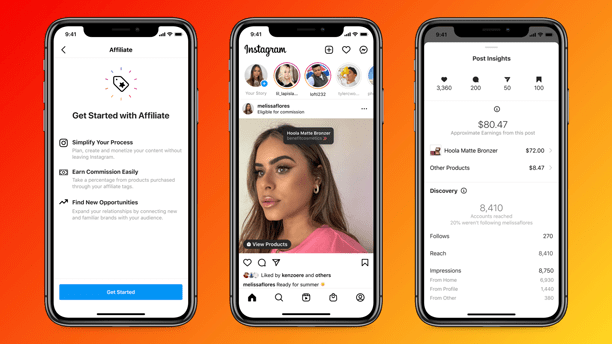SOCIAL
Social Commerce May Not be the Trend That Many Had Hoped – Which is Bad News for TikTok

Will social commerce ever catch on in western nations, and become the big money maker that it has in some Asian markets?
It’s a key question, particularly for TikTok, which isn’t able to directly monetize content through in-stream ads like other video apps. On the Chinese version of TikTok (Douyin), in-stream commerce has become its biggest income stream, with live commerce, in particular, generating big dollars for the app and its creative talent.
But thus far, users in the US and Europe haven’t shown much interest in buying on social apps, so much so that Meta has now opted to shut down its live commerce initiative on Facebook, as well as its affiliate product tagging option on Instagram.
Originally launched in June last year, Instagram’s native affiliate program currently enables eligible creators to discover new products that are available for purchase in the app, then share those products with their followers, via dedicated shopping tags. Creators then earn a commission for any subsequent purchases that they’re able to drive from their content.
It seems like a good supplementary income stream for IG creators – but again, like all in-stream shopping options, it hasn’t really caught on as Meta would have hoped.
As reported by Digiday:
“The program [has] struggled to gain adoption among creators, according to the creator industry executives. Specifically, the program involved too many steps for creators to get set up, and once a creator participated in the program, they were no longer able to tag products that were not included in the program in posts on Instagram.”
So it’s not as directly attributable as in-stream shopping, in general, not catching on, as there are other complications noted here. But you can bet that if Instagram was making money from it, it wouldn’t be shutting it down, which goes the same for live shopping on Facebook (live shopping on Instagram, however, will continue to be developed).
Which is bad for Meta, and its own commerce ambitions, which it had hoped would enable it to build on the pandemic-led eCommerce boom and establish both Facebook and Instagram as more all-encompassing discovery, recommendation and shopping platforms, in addition to their social and entertainment elements.
Indeed, Instagram chief Adam Mosseri recently addressed the lack of enthusiasm for in-stream shopping tools, explaining that:
“Many companies assumed that the swells and business they saw when the pandemic hit were an acceleration of existing trends that would have staying power. In practice it seems like almost all these trends reverted to pre-pandemic trend-lines.”
But again, this is even worse for TikTok, which is largely reliant on in-stream commerce becoming a thing in order to truly maximize its revenue potential, while also keeping its top talent aligned to the app.
TikTok too has had to scale back its eCommerce plans, with its initial push into live commerce seeing poor response in Europe, forcing it to delay its expanded rollout plans. That’s a big blow – because at the same time, more and more TikTok creators are sounding the alarm about the low payments that they’re increasingly seeing from the platform’s Creator Fund, its key, direct monetization pathway, which is subsequently seeing more and more of them spend more time creating for YouTube and IG instead, where they can make real money, without having to organize their own third-party affiliate deals.
That, eventually, could become a bigger threat to TikTok’s current dominance, while others have also noted that the app isn’t really designed to help creators build an audience, as such, as the broader content focus is more about uncovering the latest, trending posts, from anybody, as opposed to driving users to follow specific creators and accounts.
In-stream commerce is supposed to be the big thing that enables its top stars to make money directly from the app. But if users aren’t interested, and creators aren’t taking it up, as many Chinese stars have, that could be the start of a downward trend for the app, as more of them then spend their time building their audiences elsewhere.
It’s not a problem as yet. TikTok is still growing, and its addictive ‘For You’ feed continues to lure more users back to the app more often.
But what if its top stars begin posting exclusively to YouTube, and YouTube Shorts instead? What if YouTube offers them exclusive contracts, pulling their content out of the app – what if TikTok is no longer to hive of the latest, greatest trending content anymore, because people can make more money elsewhere?
It seems unlikely that TikTok’s going to lose enough momentum for that to be a real issue, with projections that it’ll soon hit 1.5 billion active users. But it does feel like an inflection point is coming, where TikTok will either need to provide another revenue pathway for its stars, or it’s usage will start to plateau, then decline slowly over time.
Maybe we’re too addicted to short-form video now for that to happen. But if the next viral, short-form trend originates from Instagram or YouTube, I’d be taking note.
It’s not going to be a sudden decline, but like Vine before it, if TikTok fails to take care of its top talent, they will start looking elsewhere.
SOCIAL
Snapchat Explores New Messaging Retention Feature: A Game-Changer or Risky Move?

In a recent announcement, Snapchat revealed a groundbreaking update that challenges its traditional design ethos. The platform is experimenting with an option that allows users to defy the 24-hour auto-delete rule, a feature synonymous with Snapchat’s ephemeral messaging model.
The proposed change aims to introduce a “Never delete” option in messaging retention settings, aligning Snapchat more closely with conventional messaging apps. While this move may blur Snapchat’s distinctive selling point, Snap appears convinced of its necessity.
According to Snap, the decision stems from user feedback and a commitment to innovation based on user needs. The company aims to provide greater flexibility and control over conversations, catering to the preferences of its community.
Currently undergoing trials in select markets, the new feature empowers users to adjust retention settings on a conversation-by-conversation basis. Flexibility remains paramount, with participants able to modify settings within chats and receive in-chat notifications to ensure transparency.
Snapchat underscores that the default auto-delete feature will persist, reinforcing its design philosophy centered on ephemerality. However, with the app gaining traction as a primary messaging platform, the option offers users a means to preserve longer chat histories.
The update marks a pivotal moment for Snapchat, renowned for its disappearing message premise, especially popular among younger demographics. Retaining this focus has been pivotal to Snapchat’s identity, but the shift suggests a broader strategy aimed at diversifying its user base.
This strategy may appeal particularly to older demographics, potentially extending Snapchat’s relevance as users age. By emulating features of conventional messaging platforms, Snapchat seeks to enhance its appeal and broaden its reach.
Yet, the introduction of message retention poses questions about Snapchat’s uniqueness. While addressing user demands, the risk of diluting Snapchat’s distinctiveness looms large.
As Snapchat ventures into uncharted territory, the outcome of this experiment remains uncertain. Will message retention propel Snapchat to new heights, or will it compromise the platform’s uniqueness?
Only time will tell.
SOCIAL
Catering to specific audience boosts your business, says accountant turned coach

While it is tempting to try to appeal to a broad audience, the founder of alcohol-free coaching service Just the Tonic, Sandra Parker, believes the best thing you can do for your business is focus on your niche. Here’s how she did just that.
When running a business, reaching out to as many clients as possible can be tempting. But it also risks making your marketing “too generic,” warns Sandra Parker, the founder of Just The Tonic Coaching.
“From the very start of my business, I knew exactly who I could help and who I couldn’t,” Parker told My Biggest Lessons.
Parker struggled with alcohol dependence as a young professional. Today, her business targets high-achieving individuals who face challenges similar to those she had early in her career.
“I understand their frustrations, I understand their fears, and I understand their coping mechanisms and the stories they’re telling themselves,” Parker said. “Because of that, I’m able to market very effectively, to speak in a language that they understand, and am able to reach them.”Â
“I believe that it’s really important that you know exactly who your customer or your client is, and you target them, and you resist the temptation to make your marketing too generic to try and reach everyone,” she explained.
“If you speak specifically to your target clients, you will reach them, and I believe that’s the way that you’re going to be more successful.
Watch the video for more of Sandra Parker’s biggest lessons.
SOCIAL
Instagram Tests Live-Stream Games to Enhance Engagement

Instagram’s testing out some new options to help spice up your live-streams in the app, with some live broadcasters now able to select a game that they can play with viewers in-stream.
As you can see in these example screens, posted by Ahmed Ghanem, some creators now have the option to play either “This or That”, a question and answer prompt that you can share with your viewers, or “Trivia”, to generate more engagement within your IG live-streams.
That could be a simple way to spark more conversation and interaction, which could then lead into further engagement opportunities from your live audience.
Meta’s been exploring more ways to make live-streaming a bigger consideration for IG creators, with a view to live-streams potentially catching on with more users.
That includes the gradual expansion of its “Stars” live-stream donation program, giving more creators in more regions a means to accept donations from live-stream viewers, while back in December, Instagram also added some new options to make it easier to go live using third-party tools via desktop PCs.
Live streaming has been a major shift in China, where shopping live-streams, in particular, have led to massive opportunities for streaming platforms. They haven’t caught on in the same way in Western regions, but as TikTok and YouTube look to push live-stream adoption, there is still a chance that they will become a much bigger element in future.
Which is why IG is also trying to stay in touch, and add more ways for its creators to engage via streams. Live-stream games is another element within this, which could make this a better community-building, and potentially sales-driving option.
We’ve asked Instagram for more information on this test, and we’ll update this post if/when we hear back.
-

 PPC6 days ago
PPC6 days ago19 Best SEO Tools in 2024 (For Every Use Case)
-

 MARKETING7 days ago
MARKETING7 days agoEcommerce evolution: Blurring the lines between B2B and B2C
-
SEARCHENGINES5 days ago
Daily Search Forum Recap: April 19, 2024
-
SEARCHENGINES6 days ago
Daily Search Forum Recap: April 18, 2024
-

 WORDPRESS6 days ago
WORDPRESS6 days agoHow to Make $5000 of Passive Income Every Month in WordPress
-

 SEO7 days ago
SEO7 days ago2024 WordPress Vulnerability Report Shows Errors Sites Keep Making
-

 WORDPRESS6 days ago
WORDPRESS6 days ago10 Amazing WordPress Design Resouces – WordPress.com News
-

 SEO6 days ago
SEO6 days ago25 WordPress Alternatives Best For SEO














You must be logged in to post a comment Login